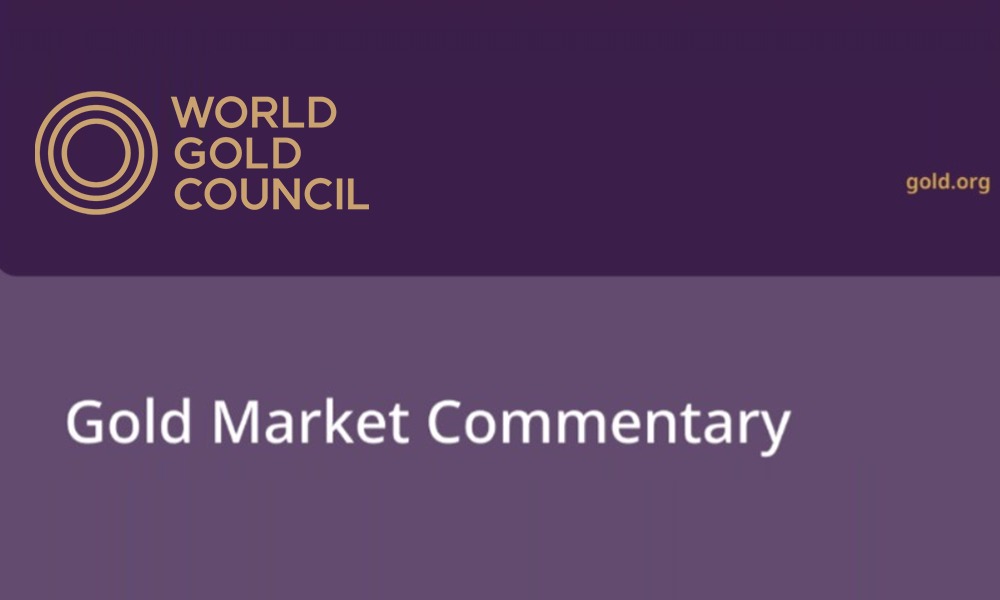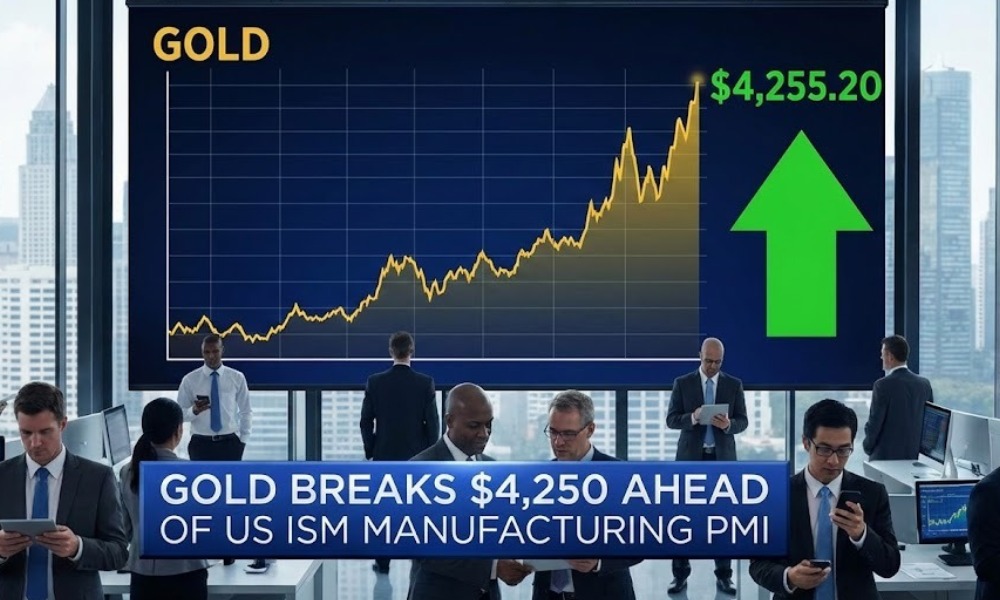International News
WGC Gold Market Commentary: ETF flows and central bank trends reports.

Dollar dive and vol spike drove gold up
Gold continued its ascent in April, breaking the US$3,500/oz mark in intra-day trading during the month.1 While gold pulled back from its record highs, it still finished strong, above US$3,300/oz and rising by 6% m/m (Table 1, p2). Gold’s return was more modest in developed market currencies and even fell slightly in Swiss francs on the back of local currency strength versus the dollar.
In fact, our Gold Return Attribution Model (GRAM) points to the significant plunge in the US dollar – captured by ‘opportunity cost (FX)’ – as one of the key drivers of gold’s performance in April (Chart 1). Other contributing factors were a spike in market volatility and geopolitical concerns (‘risk and uncertainty’). The model also suggests that there was a degree of mean reversion that created a drag on gold’s performance, as some investors likely took profits following four consecutive months of strong returns (‘momentum’).
A significantly weaker US dollar and overall heightened risk pushed gold higher during the month.
Looking forward
We expect US policy and structural inflation risk to continue driving gold investment. Profit taking could bring pause but may also encourage consumers.
Can gold’s run last?
Gold is up by nearly 27% y-t-d, significantly outperforming major asset classes.Not surprisingly, investors are asking what’s behind the move and how sustainable it might be.
Gold has been supported by a combination of:
• US trade policy uncertainty and, more generally, geoeconomic risk
• A weakening US dollar
• Higher inflation expectations combined with lower bond yields
• Continued central bank demand.
Against this backdrop, investment flows via gold ETFs have significantly ramped up. In Q1,gold ETFs amassed US$21bn of inflows – the strongest quarter in three years – with an additional US$11bn in April. Collectively, US funds have led the way, but Chinese funds have increased their holdings by a whopping 77% y-t-d.
Early innings?
Does this mean that the gold investment market is becoming saturated? We don’t believe that’s the case. Previous gold bull runs have coincided with significant inflows in gold ETFs. But there seems to be room to grow.
Risk by any other name…is still risk
Investors have grown increasingly concerned over the growth and inflation outlook from the fallout of the ongoing trade war, both in the US and globally The rise in uncertainty around trade policy and international relations has been supportive of gold as investors typically turn towards safe-haven assets for downside protection in those types of environments.
This has been exacerbated by pressure on US Treasuries and the dollar, which traditionally function as safe havens. This phenomenon is well documented by the media.In addition, conversations with wealth managers suggest that, for the first time in a long time, many investors have been seeking to hedge their overexposure to US dollar assets.
We estimate that trade concerns have accounted for approximately 10% to 15% of gold’s return y-t-d, stemming from USD devaluation, heightened geopolitical and market risk, and at least partly from some of the investment flows we’ve seen in recent weeks.
However, even if trade negotiations were to progress and conditions to improve, we would not expect gold to completely reverse its risk-induced bump.
The Fed has become a little more dovish recently. According to the Fedspeak Index, the FOMC is now very much on the fence as it balances the need to control inflation with supporting slowing growth.
Focusing on the ‘real’ side of real rates A major concern regarding US trade policies is the potential effect they could have on US and global inflation. Indeed, short-term inflation is expected to rise in the US according to consumers and market measures
Generally, high inflation is supportive for gold as investors seek out real assets for protection amidst falling purchasing power. Inflation, however, is often accompanied by higher rates that may create a drag on performance.
For one, gold remains well bid despite some easing of trade tensions and the noteworthy rebound in the US stock market since early April. In addition, investors – especially international ones – appear wary of policies on which the Trump administration may concentrate next…and all other policies that may come over the following three and a half years.
Even if the Fed were to turn more hawkish, which we believe would only occur in the event of longer-lasting inflation effects, gold could remain supported.
Using GRAM, we have analyzed the effect that changes in inflation and yields can have on gold, holding other variables constant. The main conclusion is that, in this environment, a rise in inflation will likely have a more positive effect on gold’s performance than the potential drag that higher rates may bring .
The positive effect of rising inflation on gold in the current environment may overcome a possible drag from interest rates .Hypothetical effect on gold’s return from changes in inflation and interest rates holding other drivers constant*
While investment flows are the key driver of large gold price movements, consumers are an important contributor to gold’s performance in the medium and long term. And they are key to sustaining gold trends. Higher gold prices have been deterring some jewellery buyers and while consumers can adjust to higher price levels, they still need time to adapt.
At present, recycling has remained surprisingly muted, but deteriorating economic conditions could change this, bringing additional supply and adding pressure to gold.
Central banks have also been an important source of demand for the past three years, significantly contributing to gold’s performance. We still expect central bank demand to remain robust this year, but rapidly rising prices have, in the past, temporarily decelerated purchases.
Looking beyond investors
We have covered multiple reasons why gold investment may remain strong. However, it is important to consider potential headwinds. We believe that structural reasons will enable investment demand to continue to thrive:
• Uncertainty surrounding US policies and their effect on the dollar
• More sensitivity to higher inflation expectations and a higher likelihood of lower interest rates
• Lower gold accumulation levels than in previous cycles.
That, of course, would not prevent potential pullbacks driven by profit taking or signs of advancements in trade negotiations.
Equally, for gold’s bull run to be sustainable for longer, consumers need to be given time to adapt to higher prices.
International News
Gold prices climbed above $4,250 ahead US ISM Manufacturing PMI release

US spot Gold prices climbed above $4,250 early Monday, touching a six-week high as investors turned cautious ahead of the upcoming US ISM Manufacturing PMI release. The yellow metal is poised for further upside momentum if it secures a sustained daily close above the crucial $4,250 resistance level.
The US Dollar opened December on a softer note, pressured by rising expectations that the Federal Reserve may announce a rate cut next week. Growing market confidence in easing monetary conditions has boosted the appeal of non-yielding assets such as gold.
Analysts note that a decisive break and close above $4,250 could reinforce bullish sentiment and pave the way for an extended rally in the days ahead. As global markets await fresh cues from the US economic calendar, gold continues to benefit from a favorable macroeconomic backdrop and robust safe-haven demand.
-

 BrandBuzz10 hours ago
BrandBuzz10 hours agoMCA raises “small company” thresholds – up to ₹10 cr capital & ₹100 cr turnover from 1st December 2025, major relief for jewellery trade
-

 JB Insights11 hours ago
JB Insights11 hours agoWomen Leaders Driving the Luxury Renaissance
-

 National News15 hours ago
National News15 hours agoSHINESHILPI Announces the Launch of The Shine House, India’s Biggest B2B Jewellery Hub
-

 National News13 hours ago
National News13 hours agoTalla Jewellers Successfully Hosts Free Health Checkup Camp with Fortis Escorts Amritsar and Live For Others Foundation







